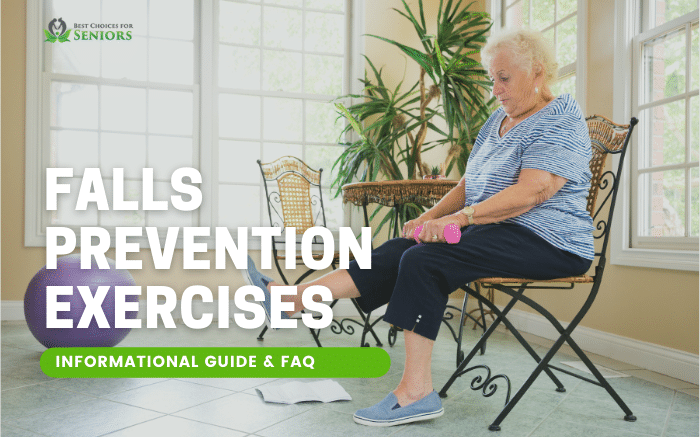Fall prevention exercises are an improvement on general balancing ones. The core of any fall prevention exercise is improving your body’s stability and balance.
The result of these exercises ranges from an increased variety of motion to better confidence while doing daily tasks.
Let’s dive straight in.
Fall prevention exercises: what, why, and how?
Let’s get the basics out of the way before we discuss the various exercises.
What are fall prevention exercises?
Fall prevention exercises for the elderly are exercises that strengthen the key muscles and joints in your body. This improves your body’s balance.
Why should you be doing fall prevention exercises?
More than 25% of older adults fall every year. These falls can often lead to serious injuries. And the injuries can make you lose your independence, mobility, or confidence.
Mitigating the fall risk starts with a well-balanced body having a strong core. Stability is very important in ensuring you don’t fall.
Fall prevention exercises solve these balance and stability issues to mitigate the risk of falling.
How to best do these fall prevention exercises?
You have to do fall prevention exercises regularly. Starting with a few reps and slowly increasing the number will allow you to become really good at them in a few weeks.
If you’re just beginning with fall prevention exercises at home, you should be more careful not to hurt yourself. If you fall during an exercise to prevent falls, it sort of defeats the whole purpose.
The time will come when you’ll be able to do many reps with ease. But it’s always recommended to start carefully and slowly build up the momentum.
Here are a few other pointers to keep in mind:
- Remember to take frequent breaks.
- Have physical support or exercise in the presence of a caregiver.
- Ignore exercises that cause you pain.
- Use a gait belt for safety if you’re frail or unsteady.
- Have a lot of patience.
With that, let’s have a look at some of the easiest, safest, and most reliable fall prevention exercises for the elderly.
Note that you need a chair or another type of physical support for many of these exercises. Whichever chair or object you choose, it has to be firm and sturdy as you’ll be putting a lot of weight on it. If it’s unsteady, you’re prone to falling while exercising.
Marching in place
One of the easiest yet the most beneficial exercises for fall prevention is marching in place.
- Stand behind a chair and hold firmly onto it.
- Make your posture upright.
- Bring your right knee up towards your chest.
- Hold for a few seconds.
- Lower them to the floor.
- Repeat with the other leg/knee.
Speed isn’t important. The only thing that matters is the number of repetitions you do. Two knee raises will amount to one step. Aim for 20 steps while marching at place. Don’t hesitate to go slow at first.
Leg raises
There are a couple of leg raise exercises that we recommend: back leg raises and side leg raises.
Back leg raises
- Hold onto sturdy support like a chair.
- Maintain a straight posture and lift your right leg backward.
- Go as high as possible.
- Hold in this position for several seconds.
- Slowly bring your leg down.
- Do the same with the left leg and repeat.
Side leg raises
- Again, hold onto a chair.
- This time, raise your right leg out to the side, as far away from the body as possible.
- Hold in this position.
- Go back to standing.
- Do the same with the left leg and then repeat.
Both these raises will help your legs in terms of flexibility and mobility. These raises are recommended regardless of any health issues as leg flexibility is very important for preventing falls and gaining balance in your posture.
Sit to stand
A sit to stand exercise requires a chair with armrests. Make sure it’s a strong and steady chair. Start with a standing position, facing away from the chair.
- Reach to the armrests of the chair to use them as support.
- Slowly sit down in the chair.
- Use your leg muscles to make yourself sit, don’t drop into the chair.
- Pushing with both your legs and arms, stand up again.
- Pause in the standing position and repeat the process.
Sit to stand exercises need to be done by applying pressure to your hand and leg muscles. Do these movements slowly and steadily. If your knees hurt, it’s okay to take longer pauses between reps.
The end goal here is hitting 10 reps per day. Stay confident and maintain a firm posture.
After a while, this will become an easy exercise. When it does, you’re ready to step up the game. Only use one hand to do this exercise and increase the number of reps.
Remember, the momentum doesn’t matter. Only the number of repetitions and your steadiness matter.
Yet another challenge after even this becomes very easy is to not use hands at all. Use just your legs to stand up and sit down. Keep your arms crossed in front of your chest.
Sit to stand reps are a great balance-improving exercise. They help you stay active while adding stability to your movements.
Final thoughts
Reducing the risk to fall is vital in old age. With regular fall prevention exercises, you’ll find a better balance and stability in your daily life. These exercises have several other benefits apart from improving your body’s balance.
If you’re under treatment then these exercises can easily be done at home. However, make sure that it’s okay for you to do them. Ask your physician for expert advice on how to best approach these fall prevention exercises.

